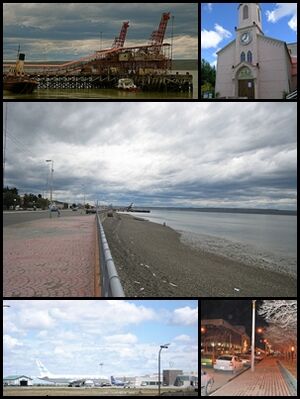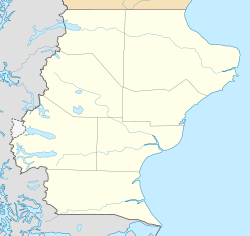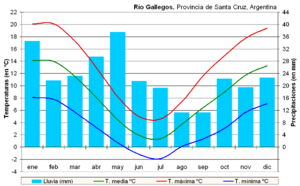Río Gallegos, Santa Cruz facts for kids
Quick facts for kids
Río Gallegos
|
|
|---|---|
|
City and Port
|
|

The Harbour of Rio Gallegos, Our Lady of Luján Cathedral Parish, Gallegos river, Rio Gallegos airport and San Martín Avenue
|
|
| Country | |
| Province | |
| Department | Güer Aike |
| Founded | 19 December 1885 |
| Founded by | Ramón Lista |
| Elevation | 20 m (66 ft) |
| Population
(2010 census)
|
|
| • Total | 97,742 |
| Time zone | UTC−3 (ART) |
| CPA base |
Z9400
|
| Dialing code | +54 2966 |
| Climate | BSk |
| Website | Official website: http://www.riogallegos.gob.ar/ |
Río Gallegos is a cool city in Argentina, located in the southern part of the country. It's the capital and largest city of the Santa Cruz province in a region called Patagonia. About 98,000 people live here.
The city gets its name from the Gallegos River, which flows into the ocean nearby. It's located about 2,636 kilometers (1,638 miles) south of Buenos Aires, Argentina's capital city.
Río Gallegos was started on December 19, 1885. The government wanted to show that Argentina controlled this southern part of Patagonia. It became the capital of the Santa Cruz area in 1888 and stayed the capital when Santa Cruz became a province in 1957.
A famous person named Néstor Kirchner, who later became the President of Argentina, was the mayor of Río Gallegos from 1987 to 1991. He is buried in a special tomb in the city's cemetery.
Contents
History of Río Gallegos
Early Explorers and Settlement
The first European to see the Gallegos River was a Spanish explorer named García Jofre de Loaísa in 1525. He called it Río San Idelfonso. Later, in 1535, another expedition led by Simón de Alcazaba y Sotomayor gave the river the name "Río Gallegos".
People didn't start living here until much later. The city was officially founded on December 19, 1885. The Argentine government wanted to make sure they had a strong presence in southern Patagonia. They built a naval base, which helped the town grow.
Growth and Development
Between 1912 and 1920, the government encouraged people from the Falkland Islands and southern Chile to move here. They offered good conditions for farming. About 3,000 new settlers arrived, which helped the town grow even more.
As sheep farming became very popular, Río Gallegos became the main port for sending sheep and their products, like wool, to other places. You can learn about the early settlers' lives at the Pioneers Museum, which is an old Patagonian house.
In 1888, Governor Ramón Lista decided to move the capital of the Santa Cruz area from Puerto Santa Cruz to Río Gallegos. This decision was officially confirmed in 1904. The main church, the Cathedral of Our Lady of Luján, was finished in 1900. Santa Cruz became a province in 1957.
Río Gallegos and Important Events
During the 1982 Falklands War, the city's airport, Piloto Civil Norberto Fernández International Airport, was an important base for the Argentine Air Force. Fighter jets like Mirage IIIs and A-4 Skyhawks used it.
Néstor Kirchner, who was President of Argentina from 2003 to 2007, was the mayor of Río Gallegos from 1987 to 1991. His special tomb is in the city, and one of the streets is named after him.
Today, Río Gallegos is still a very important city in southern Argentina. It has military bases and an international airport. Flights between Chile and Mount Pleasant Airport on the Falkland Islands even stop here once a month.
Animals and Plants
Animals of Río Gallegos
You can find many interesting birds in the area around Río Gallegos. These include the thrush, rhea (a large bird similar to an ostrich), chingolo (rufous-collared sparrow), Chilean flamingo, upland goose, and black-necked swan.
Grey foxes live here too, and they sometimes hunt the sheep that are raised on farms. Another animal you might see is the guanaco, which is related to llamas.
Plants of Río Gallegos
On the edges of Río Gallegos, there are many native plants. Some common ones include calafates (which have tasty berries), anartrofilos, oxalis, violets and pansies, paper flowers, calceolarias, hipoqueris, leucerias, perezias, senecios, mata arrears, senecio miser, amancay, lilies, and lily of the field.
Sports in the City
Río Gallegos has a main football (soccer) club called Boca Rio Gallegos. They play in the Torneo Argentino B, which is the fourth level of Argentine football. The club was started on October 12, 1945, by workers from a meat factory. They use the same team colors and logo as Boca Juniors, which is one of Argentina's most successful football clubs. Boca Rio Gallegos has been part of the national league system since 1988.
The oldest football clubs in Río Gallegos are Boxing Club, founded in August 1920, and Hispano Americano, founded on December 17, 1925.
Climate and Weather
Río Gallegos has a cold steppe climate. This means the weather is usually dry, windy, and cold. Sometimes it snows during the winter. It's known as one of the windiest cities in the world! Winds often blow faster than 50 kilometers per hour (31 mph), and sometimes even over 100 kilometers per hour (62 mph).
In winter, temperatures during the day are usually around 5°C (41°F) and drop to about -2°C (28°F) at night. But it can get much colder, with temperatures sometimes falling as low as -20°C (-4°F).
Summers are very windy and often cloudy. Daytime temperatures reach about 19°C (66°F), and nights cool down to about 7°C (45°F). Even in summer, cold weather can happen. Even though it doesn't rain much, light drizzles and cloudy days are quite common. The hottest temperature ever recorded was 35.8°C (96.4°F) on February 5, 2019, and the coldest was -20.2°C (-4.4°F) on July 12, 1982.
| Climate data for Río Gallegos, Santa Cruz, Argentina (1991–2020, extremes 1931–present) | |||||||||||||
|---|---|---|---|---|---|---|---|---|---|---|---|---|---|
| Month | Jan | Feb | Mar | Apr | May | Jun | Jul | Aug | Sep | Oct | Nov | Dec | Year |
| Record high °C (°F) | 35.0 (95.0) |
35.8 (96.4) |
33.8 (92.8) |
28.2 (82.8) |
22.6 (72.7) |
17.0 (62.6) |
16.1 (61.0) |
18.1 (64.6) |
24.9 (76.8) |
27.2 (81.0) |
30.4 (86.7) |
31.0 (87.8) |
35.8 (96.4) |
| Mean daily maximum °C (°F) | 20.0 (68.0) |
19.5 (67.1) |
17.1 (62.8) |
13.4 (56.1) |
8.8 (47.8) |
5.2 (41.4) |
5.1 (41.2) |
7.5 (45.5) |
11.3 (52.3) |
14.8 (58.6) |
17.1 (62.8) |
18.6 (65.5) |
13.2 (55.8) |
| Daily mean °C (°F) | 13.6 (56.5) |
13.0 (55.4) |
10.8 (51.4) |
7.6 (45.7) |
4.4 (39.9) |
1.6 (34.9) |
1.5 (34.7) |
3.1 (37.6) |
5.6 (42.1) |
8.3 (46.9) |
10.9 (51.6) |
12.6 (54.7) |
7.8 (46.0) |
| Mean daily minimum °C (°F) | 7.4 (45.3) |
6.9 (44.4) |
5.4 (41.7) |
2.7 (36.9) |
0.2 (32.4) |
−2.1 (28.2) |
−2.3 (27.9) |
−0.8 (30.6) |
0.8 (33.4) |
2.3 (36.1) |
4.5 (40.1) |
6.5 (43.7) |
2.6 (36.7) |
| Record low °C (°F) | −0.9 (30.4) |
−3.5 (25.7) |
−7.8 (18.0) |
−11.0 (12.2) |
−16.2 (2.8) |
−18.2 (−0.8) |
−20.2 (−4.4) |
−12.7 (9.1) |
−9.0 (15.8) |
−6.8 (19.8) |
−6.4 (20.5) |
−3.6 (25.5) |
−20.2 (−4.4) |
| Average precipitation mm (inches) | 26.9 (1.06) |
29.5 (1.16) |
28.6 (1.13) |
24.6 (0.97) |
24.3 (0.96) |
20.9 (0.82) |
19.8 (0.78) |
18.7 (0.74) |
14.6 (0.57) |
14.5 (0.57) |
22.0 (0.87) |
32.2 (1.27) |
276.6 (10.89) |
| Average precipitation days (≥ 0.1 mm) | 9.7 | 7.9 | 9.9 | 8.4 | 7.9 | 7.6 | 8.2 | 7.3 | 6.3 | 5.6 | 7.8 | 10.4 | 97.0 |
| Average snowy days | 0.0 | 0.0 | 0.1 | 0.3 | 1.1 | 3.9 | 4.0 | 2.9 | 1.5 | 0.6 | 0.3 | 0.1 | 14.6 |
| Average relative humidity (%) | 51.9 | 56.3 | 62.4 | 68.6 | 75.1 | 79.0 | 77.7 | 73.4 | 66.1 | 56.9 | 52.6 | 52.5 | 64.4 |
| Mean monthly sunshine hours | 241.8 | 200.6 | 182.9 | 147.0 | 117.8 | 93.0 | 108.5 | 139.5 | 162.0 | 210.8 | 231.0 | 232.5 | 2,067.4 |
| Mean daily sunshine hours | 7.8 | 7.1 | 5.9 | 4.9 | 3.8 | 3.1 | 3.5 | 4.5 | 5.4 | 6.8 | 7.7 | 7.5 | 5.7 |
| Percent possible sunshine | 27 | 31 | 34 | 33 | 37 | 35 | 33 | 34 | 36 | 35 | 28 | 23 | 32 |
| Source 1: Servicio Meteorológico Nacional (May record low) | |||||||||||||
| Source 2: Secretaria de Mineria (December record low only and percent sun, 1951–1980), Meteo Climat (record highs and lows), | |||||||||||||
Images for kids
See also
 In Spanish: Río Gallegos para niños
In Spanish: Río Gallegos para niños









